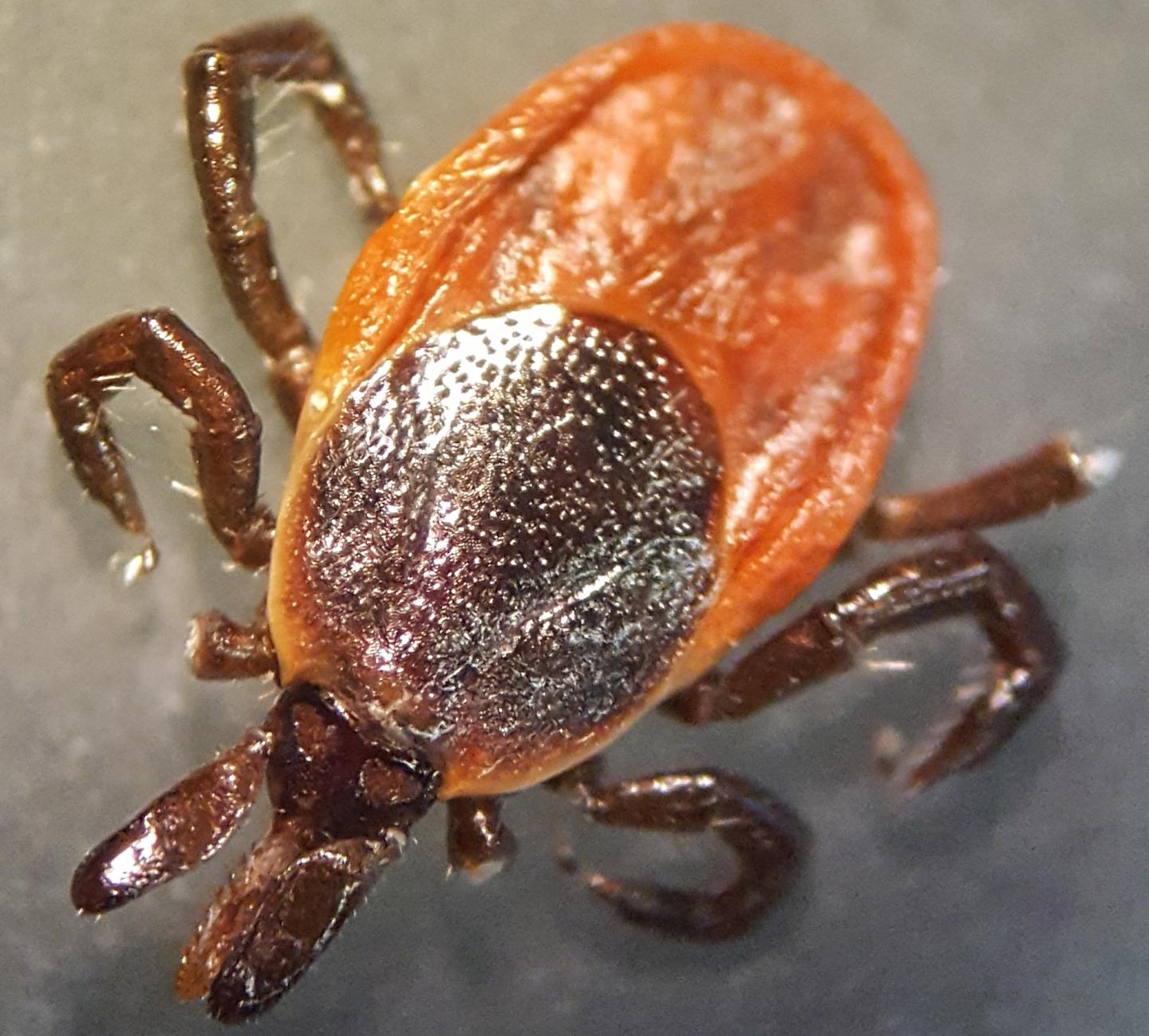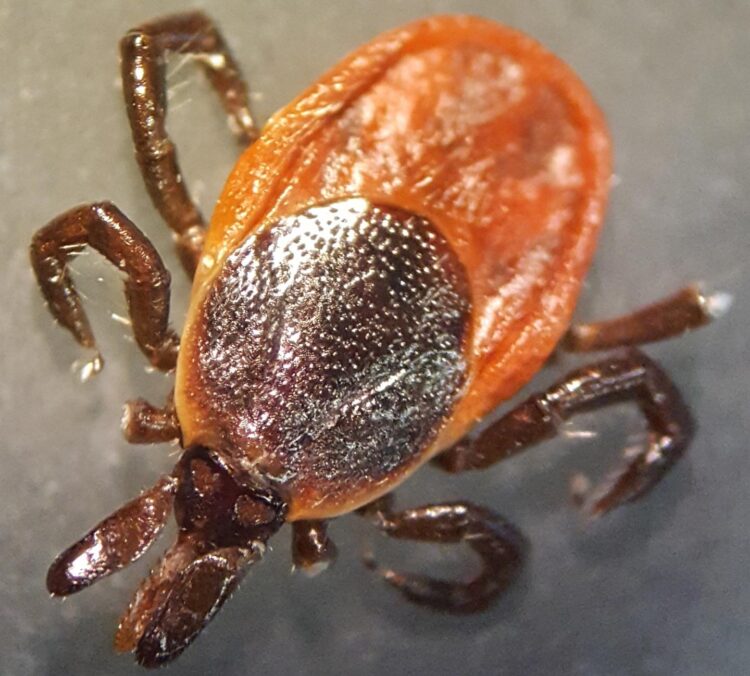
Credit: Timothy Driscoll/West Virginia University
Pesky, yet dangerous ticks are no longer latching exclusively onto hunters and outdoor enthusiasts. Milder winters and disrupted habitats have driven them out of the woods, with Lyme disease cases in the United States tripling since the late 1990s.
Now researchers at West Virginia University are working toward a vaccine that prevents humans from contracting the tick-borne illness that afflicts more than 300,000 Americans a year.
Mariette Barbier, assistant professor in the School of Medicine’s Department of Microbiology, Immunology and Cell Biology, is leading the five-year project, which received $1.9 million from the National Institute of Allergy and Infectious Diseases. Joining her on the project are Timothy Driscoll, assistant professor of biology in the Eberly College of Arts and Sciences, and Heath Damron, assistant professor and director of the WVU Vaccine Development Center.
Despite the annual rise in cases, no vaccine exists for Lyme disease.
“The tick population is increasing in the U.S. and the impact of Lyme disease is expanding over Appalachia, in particular West Virginia,” said Barbier, who’s researched vaccines for whooping cough, lethal pneumonia and other infectious diseases. “We’re trying to develop a vaccine that would be broadly protective against various species of Borrelia (the bacterium that causes Lyme disease).”
The Centers for Disease Control and Prevention categorizes West Virginia as one of 14 states with a “high incidence” of Lyme disease cases. As of 2016, 11 counties – Berkeley, Hampshire, Hancock, Jefferson, Kanawha, Marshall, Mineral, Morgan, Roane, Wetzel and Wood – are considered “endemic.”
Lyme disease is commonly spread through the bite of infected ticks, which carry Borrelia. After bitten, a red rash can emerge on the skin and resemble a bull’s-eye. If untreated, Lyme disease can lead to debilitating conditions such as arthritis, muscle pain, meningitis and heart and brain inflammation.
What makes researchers tick
Through RNA sequencing, Barbier and her team will examine how pathogens respond in both infected ticks and mice to determine what’s needed for Lyme disease vaccine development. Researchers hope to identify relevant antigens – substances that cause the immune system to produce antibodies against it – during the infection phases.
“When we design a vaccine, we usually aim for proteins that appear on the surface of whatever pathogen we want to vaccinate against,” explained Driscoll, who runs the Vector-Borne Disease Laboratory in biology. “In the case of Borrelia, certain of those proteins are required for the normal functioning of the bacteria. In vaccine development, what we try to do is identify those proteins and target them in hopes of clearing the pathogen out, killing it, essentially. If a protein is essential for survival, it makes it harder for the pathogen to change it and evade the immune system.”
Driscoll’s role will primarily involve studying Borrelia during its passage through black-legged ticks, which primarily feed on mammals ranging from rodents to deer. That’s how Borrelia survives over the winter, Driscoll added, as ticks attach to animals such as mice and infect them with the bacterium, which is then picked up by the next generation of ticks.
“My part of this project is looking at what proteins are made by Borrelia during the tick life cycle, in order to identify targets that the pathogen needs to survive in this environment,” he said.
For Barbier, the challenge to develop a vaccine is also one of personal and professional curiosity. She’s spent her career studying bacterial pathogens, one of them being Pseudomonas aeruginosa, which causes respiratory and skin infections.
“We figured out which antigens could be used to formulate a vaccine, and found the Achilles heel to the bacteria to use against it,” Barbier said. “We focused on one system, which is the iron acquisition system of Pseudomonas.”
To grow and infect their host, bacteria such as Pseudomonas must acquire key nutrients such as iron.
Barbier recognized one exception: Borrelia. The causative agent of Lyme disease does not use iron.
“That’s really piqued my interest,” Barbier said. “If it doesn’t use iron, what else can we use against it? By bringing in the expertise of others, we’re going to crack the problem.”
The vaccine will be a preventative measure against Lyme disease, not a treatment, researchers said. When detected early enough, infections with Borrelia can be stopped with antibiotics. However, the pathogen can often go undetected, leading to the development of Lyme disease. An effective vaccine would prevent infections from happening in the first place.
Once a vaccine has been tested and proven successful in pre-clinical models, the WVU Vaccine Development Center will work with potential commercial partners to put the vaccine through clinical trials, and eventually on the market,” said Justin Bevere, assistant director of the Center.
“One of the goals of the Vaccine Development Center is to help researchers move their vaccines out of the academic lab and into the market,” Bevere said. “We do that by partnering with biotechnology and pharmaceutical companies. We are actively seeking collaborators for this Lyme disease vaccine project.”
Until then, Driscoll recommends everyone to take the necessary precautions in preventing tick bites: using insect repellent and checking for ticks on the body after spending time outdoors.
“As we get milder winters, ticks tend to be more active,” Driscoll said. “We’re also seeing an increase due to disrupted habitats. As we build roads and neighborhoods in forested areas, mice and rabbits and other animals that harbor borrelia are coming in close contact with humans.”
Media Contact
Jake Stump
[email protected]
Original Source
https:/





